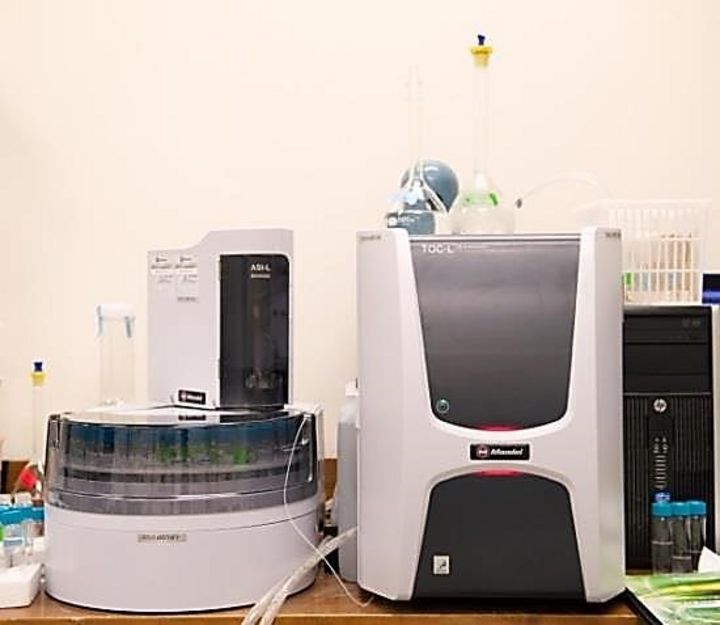
- Atomic absorption spectrophotometer (flame and graphite furnace)
- Automated titrator and Karl Fisher
- Capillary electrophoresis
- Differential Scanning Calorimeter (DSC)
- Fluorescence Spectrometer X (XRF)
- FTIR infrared spectrometer with cell specialized in gas and biogas analysis
- Fluorimeter
- Gas chromatograph (GC-TCD) for gas analysis
- Gas chromatograph (GC-FID)
- FTIR Infra-Red Spectrometer For Solid And Liquid Samples
- Ion chromatography
- Gas chromatograph combined with a mass spectrometer (GC-MS)
- High-performance liquid chromatography combined with an ion-trap mass spectrometry (LC-MS)
- High-Performance Liquid Chromatography (2 Units, One Of Which Is Equipped With A Fraction Collector)
- High-Performance Liquid Chromatograph With An ELSD Detector (Electrospray Light Scattering Detector)
- Kjeldahl analyzer (total nitrogen and ammonia)
- Spectromètre d’émission optique muni d’un plasma à couplage inductif (ICP-OES)
- Thermogravimetric analyzer coupled with mass spectrometer (TGA-MS)
- Total organic carbon analyzer
The Laboratory for Ecotoxicogenomics and Endocrine Disruption (LEPE) brings together the expertise, knowledge, infrastructure and instrumentation necessary to test the effects of contaminants on the health of living organisms. The experiments are carried out in the laboratory, in microcosm, in mesocosm and in the field. The team is developing unique biomarkers for each target species in order to understand and validate the mechanisms of action of contaminants. The group also specializes in the study of endocrine disruptors and has, among other things, ultra-sensitive cell lines that identify contaminants capable of altering the hormonal response.
This pilot laboratory is a powerful, mobile and flexible infrastructure for testing and demonstrating, at low cost, and directly in industrial environments or on degraded sites, new remediation and decontamination processes before their implementation on a real scale. . The laboratory team works to develop technologies for the treatment, decontamination and recovery of various matrices polluted by metals and other types of pollutants. The development of processes contributing to sustainable development in the field of environmental technologies is a priority research area of the INRS. The laboratory has a multifunctional mobile pilot plant to operate various types of physical, chemical and biological processes for the treatment of soils, hazardous wastes, gases, as well as industrial residues and effluents directly on contaminated sites.
/// Features:
- Processing volume: 1 to 4 L
- Operating pressure up to 600 psi
- Feed flow ranging from 1 L/min to 6 L/min
- Membrane coupons for MF, UF, NF, and OI
- Can be adapted to forward osmosis
/// Samples:
- Liquids: effluents, residual liquids, process waters, fluids, etc.
/// Examples of applications
- Scanning and selection of the type of membrane to be used
- Optimization of membrane filtration parameters: flow, pressure, temperature
- Studies of the effects on liquids and membranes (precipitations, clogging, pressure drop, etc.)
/// Features:
- Enables the simultaneous testing of several flocculation / pre-filtration conditions
/// Examples of applications:
- Separating and concentrating metal nanoparticles
The BioEngine laboratory in the Department of Chemical Engineering at Université Laval includes high-end equipment and pilots for resource recovery from waste materials and polluted water. It includes methanogenic potential reactors (BMP), semi-continuous biomethanization reactors in 1, 2 or 3 phases, composting and controlled aerobic conditioning reactors, a fluidized bed granulator, a pilot for phosphorus recovery by adsorption, a nitrogen recovery set-up by stripping and absorption, a membrane bioreactor, a measurement station for real-time monitoring of physicochemical and biological parameters, as well as equipment for characterizing water and residual organic matter.
Analysis of trace metals in liquid or solid samples (biological tissues, suspended matter, sediments, soils) and bio-optical analysis. Research focuses on the path of toxic metals in the food chain, the bioavailability of contaminants, the impacts of anthropogenic activities and the assessment of the sensitivity of the natural environment. The main equipment is as follows: Particle and radioactivity counters (beta and gamma emissions); Atomic and mass emission spectrometers, by inductively coupled plasma (ICP-AES and ICP-MS); Liquid, gas and ion chromatography devices (HPLC, LC-MS-MS, GC, GC-MS); ICP-MS coupled to an HPLC; Mercury analyzer.
The microanalysis laboratory offers the scientific community, businesses and industry a characterization service for natural and synthetic materials. The laboratory operates a CAMECA SX-100 electronic microprobe and a JEOL 840-A scanning electron microscope (SEM). The laboratory also operates a Siemens D5000 X-ray diffractometer.
///Features :
- Filtration system with three ceramic membrane chambers measuring 110 cm in length by 2.5 cm in diameter (microfiltration and ultrafiltration)
- Filtration capacity of 150 L to 200 L per hour; 600 L double walled tank connected to a cooling system
- Pre-filter; Pump with a maximum operating capacity of 3500 rpm (8 horse power).
/// Samples :
- Liquids (effluents, residual liquids, fluids, liquid waste, liquids resulting from chemical processes, and so on)
- Capacity to process samples of up to 1 000 L.
/// Examples of applications :
- Industrial effluent treatment; Molecule separation, concentration, and purification (organic or inorganic)
- Recycling of harmful biomass
- Extraction of recyclable organic compounds
- Recycling of waste products (polyethylene glycol, cutting fluids, essential oils, etc.)
- Separation of nanoparticles from dissolved salts in order to characterize the nanoparticle content - Nanoparticle and other nanomaterial concentration.